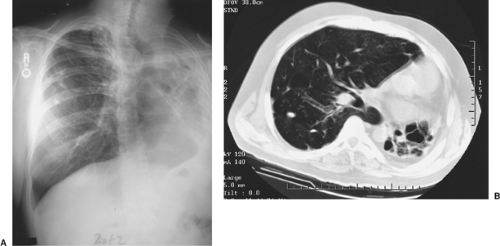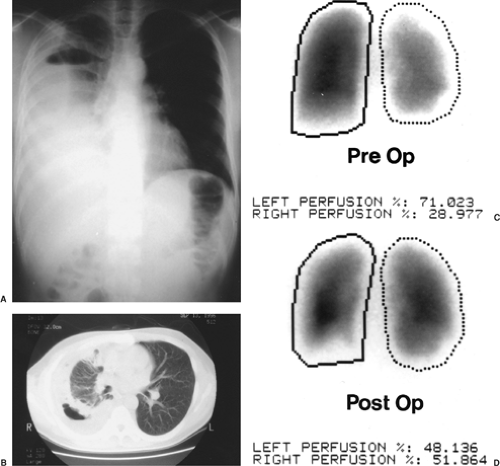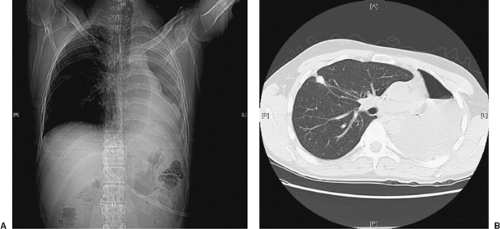Surgery for the Management of Mycobacterium Tuberculosis and Nontuberculous Mycobacterial (Environmental) Infections of the Lung
Marvin Pomerantz
John D. Mitchell
Mycobacterial pulmonary disease includes infections with Mycobacterium tuberculosis—a virulent organism that rapidly destroys normal lung tissue and produces an acute illness with significant systemic effects—as well as infections with other mycobacteria. The latter have been called atypical tuberculosis, nontuberculous mycobacterial (NTM) infections, infection from mycobacteria other than tuberculosis (MOTT), and more recently environmental mycobacterial (EM) infections. The term EM is probably the best descriptive name. These infections have also been described by the color they produce on culture plates or by their speed of growth in culture (rapid growers). In contrast to tuberculosis (TB), they most often infect previously diseased lung. The EM infections are more indolent and are often ignored or are treated over many years before the disease is eradicated, surgery is required, or lung destruction is so severe that only supportive measures can be used.
In 2005 the World Health Organization (WHO) reported 8.8 million new cases of TB worldwide, with 7.4 million in Asia and sub-Saharan Africa. The WHO also reported 1.6 million deaths from TB in 2005.a In 2005, a total of 14,093 TB cases were reported in the United States, a 3.8% decline from 2004.b
Unfortunately the incidence of multidrug-resistant tuberculosis (MDR TB) is slowly rising. This is particularly a problem in Russia, where the Beijing strain is highly virulent. Zignol et al.53 estimate that the total number of MDR TB cases in 2004 was 203, 424. They also assume that if the duration of the disease (MDR TB) is 2 to 3 years, the global prevalence of MDR TB would be 850,000 to 1,300,000. These patients who are resistant to INH and rifampin often are resistant to multiple other drugs and therefore are more difficult and much more expensive to treat than drug-sensitive TB. The emergence of extensively drug-resistant TB (XDR TB) presents an additional problem. These organisms are resistant to most of the first- and second-line drugs including the flouroquinolones. Therefore those patients infected with XDR TB present an additional challenge to the clinician.
Fortunately, only 10% to 15% of those exposed to the TB bacillus come down with the clinical disease, as noted by Iseman.20 The WHO estimates that one-third of the world’s population is infected with M. tuberculosis. According to Reichman,40 TB most likely spread from animals to humans 8,000 to 10,000 years ago. This spread is similar to the spread of AIDS in the twentieth century. The primary difference is that TB is spread by airborne droplets, not by body fluids or infected blood. The 85% to 90% of people who do not develop symptoms of TB remain a population with latent disease for later activation, most often in old age, when their immune systems break down.
Robert Koch first identified the TB bacillus in the 1880s. The early treatment of TB gave rise to the sanatorium system in the late 1800s and the early 1900s. Fresh air and rest were presumed to be beneficial for the treatment of TB; however, there was probably more benefit to society from the isolation of the infection than to the individual being treated.
Surgical treatment for TB began with collapse therapy. This was effective because M. tuberculosis is an obligate aerobe; by collapsing cavitary disease, these organisms, which number in the billions in tuberculous cavities, would be deprived of oxygen and thus die. In 1906, Forlanini13 claimed credit for introducing collapse therapy; however, it had been performed in a few cases prior to that time by several other surgeons. Various
forms of collapse therapy were employed until the introduction of chemotherapy in 1945. The different forms of collapse therapy included thoracoplasty, induced pneumothorax, wax or Lucite ball plombage, pneumoperitoneum, and phrenic nerve crush or interruption.
forms of collapse therapy were employed until the introduction of chemotherapy in 1945. The different forms of collapse therapy included thoracoplasty, induced pneumothorax, wax or Lucite ball plombage, pneumoperitoneum, and phrenic nerve crush or interruption.
Chemotherapy for TB started with the introduction of streptomycin and para-aminosalicylic acid (PAS) in about 1945. However, it was not until 1952, with the introduction of isoniazid, that enduring cures could be obtained. With the advent of the aforementioned drugs, surgical resection replaced collapse therapy in those who might benefit from the combination of drug therapy and surgery. With the introduction of rifampin into clinical use in 1966, the need for surgery was markedly reduced; thus the closing of the TB sanatoria began. Today they are essentially nonexistent.
One of the current medical treatments of drug-sensitive TB is with isoniazid, rifampin, and a short course of pyrazinamide. Until specific sensitivities are obtained, ethambutol is added if resistance is expected. In addition to isoniazid, the first-line drugs used in the treatment of TB are rifampin, pyrazinamide, ethambutol, and streptomycin. Additional drugs used in the treatment of TB as well as other mycobacterial infections include cycloserine, ethionamide, PAS, ofloxacin, clofazimine, clarithromycin, and amikacin. Treatment is usually for about 6 months and must include directly observed therapy (DOT). Without DOT, patients often do not take their medication because of the frequent side effects. Under these circumstances there is a much greater risk of developing drug-resistant TB or MDR TB, which implies resistance to isoniazid and rifampin. The two major problems facing those medically treating TB is the development of MDR TB and the synergy between TB and AIDS. Dye and associates9 state that in sub-Saharan Africa, TB accounts for over 20% of deaths among AIDS patients, and TB now accounts for 15% of all AIDS deaths worldwide.
Surgical Resection of Parenchymal Disease Caused by Multidrug-resistant Tuberculosis
Surgery plays a role in the treatment of patients with TB. Patients with lungs destroyed by MDR TB (Fig. 91-1) or cavitary disease (Fig. 91-2), with or without positive sputum smears, will require resection; this is currently the most frequent indication for surgery in patients with TB in the United States. Incidentally, treatment of MDR TB may cost up to 100 to 200 times
more than treatment of patients with drug-sensitive TB. Decortication alone for management of a trapped lung is sometimes indicated (Fig. 91-3). Other patients who require surgical intervention include those with bronchopleural fistulas, massive hemoptysis (>600 mL in 24 hours), bronchostenosis, or those in whom there is a need to rule out cancer.
more than treatment of patients with drug-sensitive TB. Decortication alone for management of a trapped lung is sometimes indicated (Fig. 91-3). Other patients who require surgical intervention include those with bronchopleural fistulas, massive hemoptysis (>600 mL in 24 hours), bronchostenosis, or those in whom there is a need to rule out cancer.
Pomerantz and colleagues36 note that for unknown reasons, when there was total lung destruction, the left lung was involved in three-fourths of the patients in the series studied. Van Leuven and associates48 reported an 80% incidence of left-sided pneumonectomies. Earlier, Ashour and colleagues3 reported a like experience (12 of 13 pneumonectomies were performed on the left side). In a later follow-up by Ashour,2 16 of 20 pneumonectomies were done on the left. Ashour and associates3 suggest that the propensity for left-sided lung destruction in patients with resistant M. tuberculosis infection is possibly related to the smaller caliber (10%–15%) of the left mainstem bronchus, the tight space surrounding it in its passage through the mediastinum, and the angle of its takeoff from the trachea. Also, the anatomic configuration of the left-upper-lobe bronchus to the left-lower-lobe bronchus may play a role. In lobar disease, as in most airborne diseases, the right upper lobe is the lobe most frequently involved, followed by the left upper lobe.
In patients with XDR TB, similar indications for surgical intervention exist as for MDR TB. Surgical resection is probably
of greater benefit in XDR TB if disease is localized owing to the lack of good drug therapy.
of greater benefit in XDR TB if disease is localized owing to the lack of good drug therapy.
Preoperative Preparation
Preparation for surgery is critical, with nutritional support being essential. Most of these patients have lost weight—some as much as 30 to 40 pounds. Additional nutrition via gastrostomy or jejunostomy tube may be needed to ensure that the patient is anabolic prior to surgery. Surgery should not be performed on patients whose albumin level is <3.0 g/dL. The patient should be on the best available antimycobacterial therapy based on culture and sensitivity data for approximately 3 months prior to surgery. If bacterial counts from sputum samples are still decreasing, antibiotics can be given for a longer period; or, if a negative sputum result occurs, surgery can be done earlier. In about 50% of surgical patients with MDR TB, negative sputum cultures cannot be obtained and surgery has to be done in spite of positive sputum results.
One of the important principles of surgery is to leave enough viable lung based on pulmonary function tests to ensure that the patient will be able to function reasonably well after surgery. Therefore pulmonary function tests and perfusion scans must be obtained preoperatively to be certain that the patient will tolerate the proposed resection. Based on a 70-kg patient, a calculated forced expiratory volume in 1 second (FEV1) of 1 L should be left after the indicated resections are completed. Even if the radiographic appearance of the lung suggests that a lobectomy would be adequate, a perfusion scan showing only ≤15% going to what would be the remaining lung on the operative side is an indication for pneumonectomy.
Improvement in pulmonary hygiene is essential in the preoperative management of mycobacterial patients. The remaining lung, though appearing normal, usually has some degree of infectious involvement. These patients are more apt to develop atelectasis and other pulmonary complications postoperatively. Ideally, patients should not smoke for 1 month prior to surgery. The use of postural drainage, the acapella valve, and incentive spirometry should be taught preoperatively.
Surgical Technique
Double-lumen endobronchial tubes or bronchial blockers are used to anesthetically isolate the lungs during anesthesia and the surgical procedure. At least one large intravenous line is placed to replace blood if needed. An epidural catheter is placed for pain control postoperatively. Alternatively, intrathecal one-dose analgesia can be utilized and then switched to patient-controlled analgesia when the effect wears off.
A posterior lateral thoracotomy incision is routinely employed. In extensive TB, the pleura is usually fused; therefore thoracoscopic resection is uncommon. All grossly involved lung should be removed. Cavitary disease has been found to have 107 to 109 organisms versus 102 to 104 organisms in nodules; therefore all cavitary disease should be removed. Additionally, all destroyed lung should be resected. Nodular disease without cavitation does not require resection. Resectional surgery is often done in the extrapleural plane. Dense adhesions are usually found over the apical and posterior segments of the upper lobe and often over the superior segment of the lower lobes. There is often a free plane of dissection over the aortic arch on the left and the azygos vein on the right. In dissecting in the extrapleural plane, care must be taken to avoid the subclavian vessels, the recurrent laryngeal nerve, the esophagus, and the intercostal vessels during dissection posterior to the aorta, as emphasized by Brown and one of the present authors.4 Once the lung is freed from its adhesions, the hilum can often be isolated without difficulty. However, with completion pneumonectomies, vessel ligations may have to be performed within the pericardium.
Bronchial closure can be done either with suture or staples. In mycobacterial resections, the authors have found no difference in the incidence of bronchial stump disruption with either closure. Muscle flaps, although thought to be controversial by some, should be used to cover the bronchial closure in patients who still have a positive sputum smear at the time of surgery, in those who have a bronchopleural fistula, or if there is polymicrobial contamination. They also may be used if there is a need to fill space after a lobectomy. The authors and colleagues37 have recommended the latissimus dorsi as the muscle of choice. Using the serratus anterior produces a winged scapula, which may protrude under the posterior portion of the wound in these usually cachetic patients. When only support of the bronchial closure is needed following a pneumonectomy, an intercostal muscle flap may be used. When there is no muscle available owing to previous surgery or if there is massive contamination, an omental flap is used. Although there is no controlled series regarding muscle flaps, fewer bronchopleural fistulas seem to be encountered when a muscle flap is used for the aforementioned reasons. The use of omental flaps may further decrease the incidence of bronchopleural fistula, particularly after right pneumonectomy and completion pneumonectomy. Muscle flaps are not used for resections of the middle lobe and lingula, segmental resections, or lower lobectomies. In our experience, it is rare to have a bronchial stump break down with these procedures. However, whenever possible in these procedures, a pleural flap or pericardial fat pad should be used for bronchial stump coverage.
At the completion of surgery, bronchoscopy is usually done to cleanse the tracheobronchial tree of secretions that may be present from manipulation of the lung during resection. The amount of crystalloid fluid administered intraoperatively should be limited to about 800 to 1,000 mL for pneumonectomies and 1,200 mL for lobectomies.
In very contaminated cases, an Eloesser procedure11 is performed after the resection. The Eloesser flap is closed 4 to 6 weeks later after daily packing with Kerlix gauze soaked in half-strength Dakin’s solution. At the time of closure, a modified Clagett solution is placed into the pleural cavity.
Postoperative Care
Fluids are restricted for the first 3 to 5 days. Following lobectomy, fluids are restricted to 1,800 mL/24 hr; after a pneumonectomy, they are restricted to 1,500 mL/24 hr. Ambulation is encouraged on the first postoperative day. Compression stockings are used and pulmonary hygiene is continued. Heparin (5,000 U) is given subcutaneously twice daily until the patient is fully ambulant. Ketorolac is used for several days if renal function is normal. Epidural analgesia is continued for 48 to 72 hours, after which patient-controlled analgesia is instituted. Passive range-of-motion exercises are begun on the upper extremities to prevent a frozen shoulder. Nutrition is emphasized in the postoperative period, as it is preoperatively. When the infected lung is removed, appetite often improves and the patient may
become anabolic. However, side effects from the antibiotics may continue to affect caloric intake negatively. Appropriate antimycobacterial drugs are continued for 12 to 24 months as indicated, with some injectable medications being stopped first.
become anabolic. However, side effects from the antibiotics may continue to affect caloric intake negatively. Appropriate antimycobacterial drugs are continued for 12 to 24 months as indicated, with some injectable medications being stopped first.
Complications
A dreaded complication following surgery for MDR TB is a bronchopleural fistula. This is more common after right than left pneumonectomies. Other factors increasing the incidence of bronchopleural fistulas are positive sputum culture at the time of operation, significant polymicrobial contamination, diabetes, and prior chest wall irradiation. The incidence of bronchopleural fistulas if these factors are present is >5%. In contrast, with middle lobe, lingular, lower lobe, and segmental resection, the incidence is much less than 5%. Postpneumonectomy pulmonary edema is a lethal complication and can occur without fluid overload. It is more common after a right than a left pneumonectomy. Treatment is supportive, with ventilatory assistance, monitoring of pulmonary pressures, diuresis, and other supportive measures, but it is often a lethal complication in patients with MDR TB. If pulmonary hypertension is present, it is treated with nitroglycerine, nitroprusside (Nipride), or nitric oxide.
Atelectasis, pneumonia, or both are common after mycobacterial surgery. Unlike cancer patients who undergo surgery, when after resection the remaining lung may be more normal, the mycobacterial patient usually has other diseased lung remaining. Therefore pulmonary complications are harder to treat in MDR TB patients. Prevention using incentive spirometry, the acapella valve, and physiotherapy is essential.
Wound complications are frequent in these catabolic patients. Seromas often form from the latissimus dissection area when muscle flaps are used. Suction drains should be left in these areas until little drainage (<25 mL) is collected in a 24-hour period.
Other complications include postoperative bleeding (often a frequent complication in many of the reported series, such as those of Treasure and Seaworth46 and van Leuven and associates,48 among others), injury to the recurrent laryngeal nerve, and empyema. All of these complications occur more commonly in MDR TB surgery because of the adhesive infected nature of the disease process as well as the debilitated catabolic condition of the patient. Despite the possibility of a high complication rate following these surgical procedures, Pomerantz and colleagues of our group36 reported only 20 adverse events in 178 resections in 170 patients (11.2%) with MDR TB. The mortality rate was 3.3%. Moreover, in patients with MDR TB who are good surgical candidates, cure can be obtained in over 90% of cases if antimycobacterial agents are continued for the appropriate time postoperatively.
Stay updated, free articles. Join our Telegram channel

Full access? Get Clinical Tree






